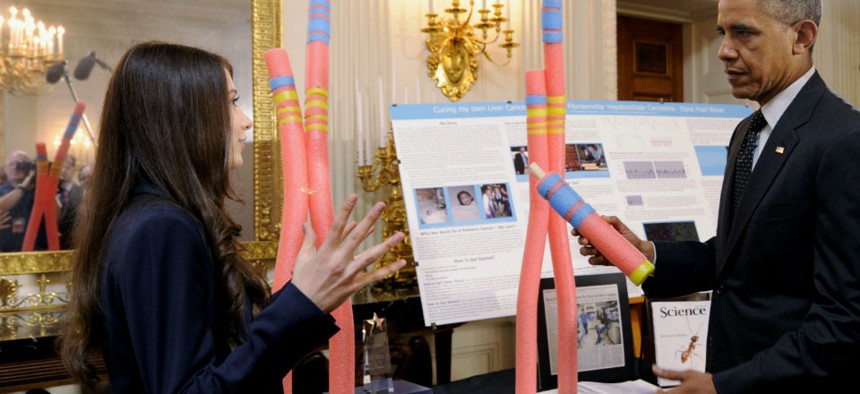White House Spotlights Contributions of Girls in STEM

President Barack Obama talks with Elana Simon, 18, of New York City, about her cancer research project that is part of the 2014 White House Science Fair exhibit. Susan Walsh/AP
Science Fair emphasizes young women who are excelling in science, technology, engineering and math.
The White House on Tuesday welcomed some of America’s most innovative students for the fourth-ever White House Science Fair, which this year emphasized the specific contributions of girls and young women who are excelling in science, technology, engineering and math.
Among those highlighted at the conference was Elana Simon, 18, who was diagnosed with a rare liver cancer at age 12, and her work with one of her surgeons to find a common genetic mutation across samples of other patients coping with the same cancer.
Cassandra Baquero, 13, Caitlin Gonzolez, 12 and Janessa Leija, 11, of Los Fresnos, Texas, also showcased their work as part of an all-girl team of app builders who built “Hello Navi,” an app that gives verbal directions to help their visually-impaired classmates navigate unfamiliar spaces based on measurements of a user’s stride and digital building blueprints. Girl Scout Troop 2612 of Baltimore, Md., demonstrated their computer program designed to automatically retract a bridge when flood conditions are detected by a motion sensor embedded in the river bed.
In remarks after viewing this year’s science projects, President Obama cited statistics that just one in five Bachelor’s degrees in engineering and computer science are earned by women, while fewer than three in 10 workers in science and engineering fields are women.
“That means we have half of our team we’re not even putting on the field,” Obama said. “We have to change those numbers. These are the fields of the future.”
Obama announced new efforts to invest in STEM education, including a $35 million grant competition by the Education Department to help train and prepare STEM teachers in support of the President’s goal to train 100,000 excellent STEM teachers.
The president also announced an expanded effort to provide STEM learning opportunities to more than 18,000 low-income students this summer through the STEM AmeriCorps program, which launched at the 2013 White House Science Fair. The summer program will bring together AmeriCorps members with community groups, educational institutions and corporate sponsors to help students learn about STEM – from building robots to writing code for the International Space Station to participating in “scientist-for-a-day” programs to explore various careers.
Seven cities across the country also will launch STEM mentoring efforts through the US2020 City Competition, sponsored by Cisco, which challenges cities to develop innovative models for scaling STEM mentorship for young students, particularly girls, minorities and low-income families. The goal of the program is to mobilize 1 million STEM mentors annually by the year 2020.
“Last week, we had the Superbowl champion Seattle Seahawks here, and that was cool,” Obama said. “But I believe what’s being done by these young people is even more important. As a society, we have to celebrate outstanding work by young people in science at least as much as we do Superbowl winners.”






